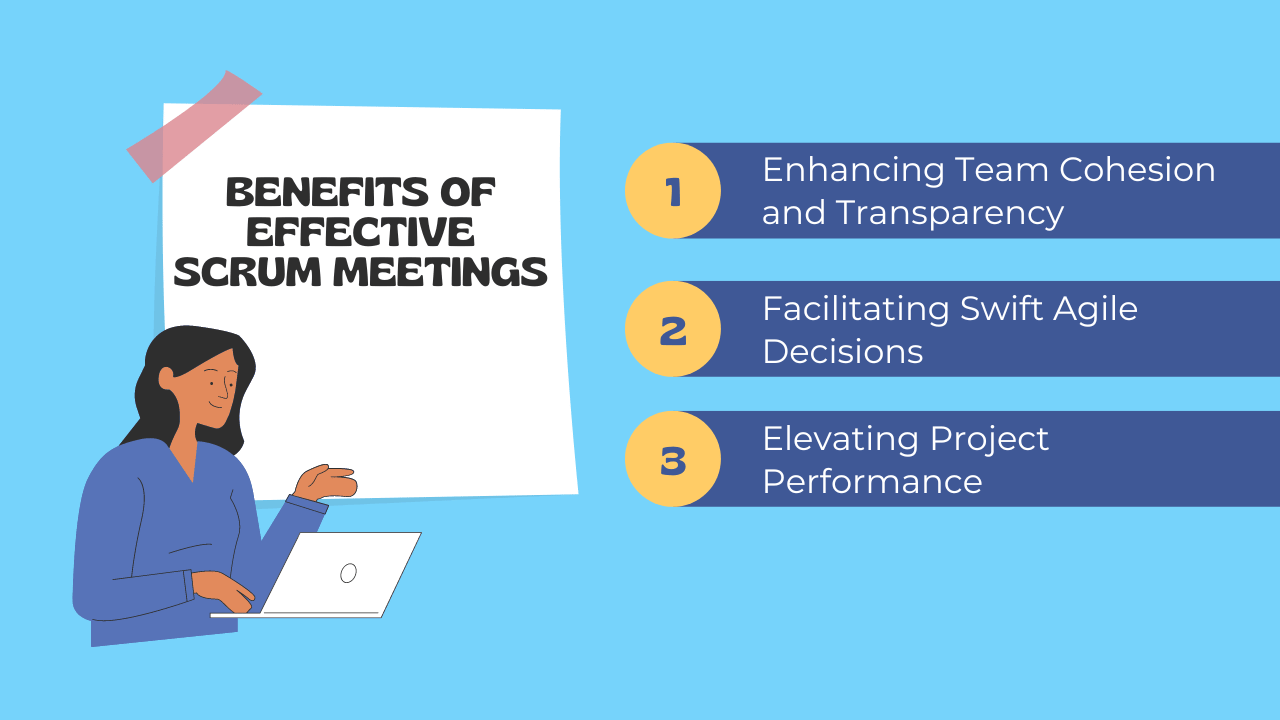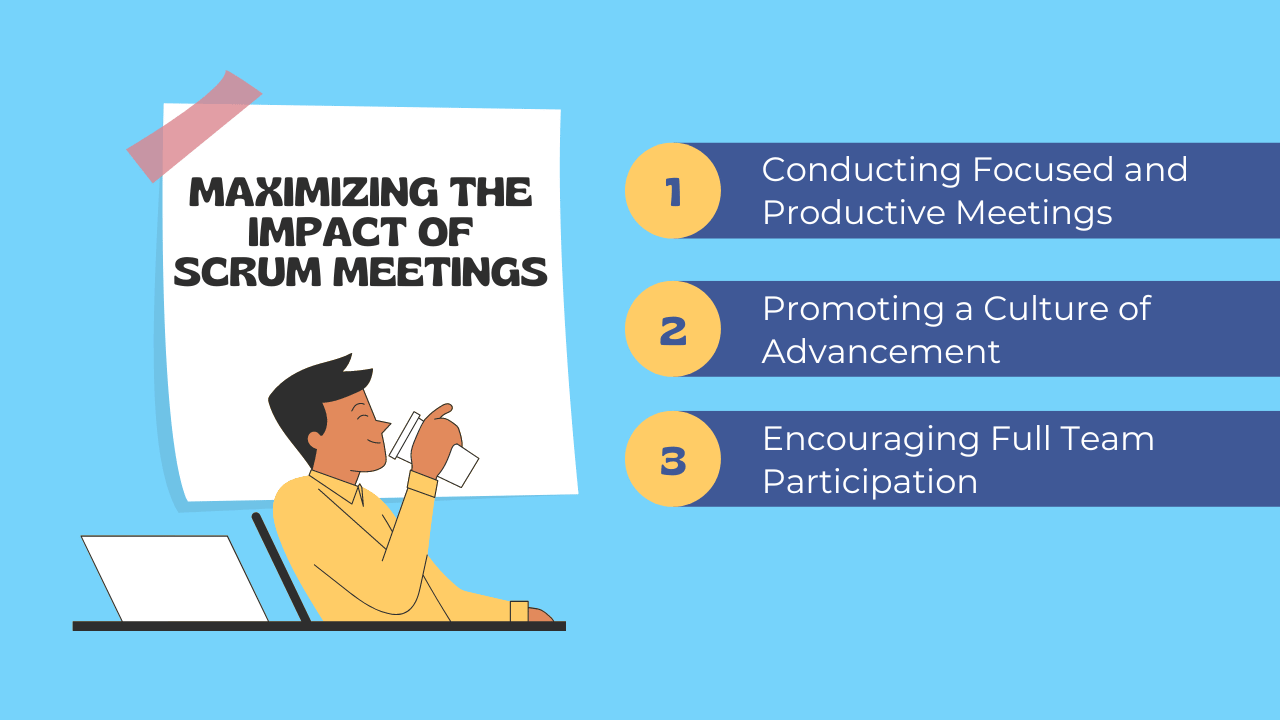
What is a Scrum Meeting? | Definition, Overview, and Scheduling
 What is a Scrum Meeting? | Definition, Overview, and Scheduling
What is a Scrum Meeting? | Definition, Overview, and Scheduling
Scrum meetings are critical to the agile methodology, fostering teamwork, refining processes, and boosting efficiency among agile scrum teams.
These meetings, often characterized by their brisk and focused nature, serve as the daily heartbeat of Scrum teams around the globe.
💡
These sessions include various types of meetings, each to boost teamwork, refine workflow processes, and encourage an environment ripe for ongoing enhancement.
These meetings, also known as Scrum events, are critical to maintaining alignment of all stakeholders - from management and teams to other involved entities - throughout the project's progression.
At their core, Scrum meetings, or Daily Standups, aim to foster open communication, quick decision-making, and a clear direction for the day ahead. By bringing together the Scrum Master, Product Owner, and development team, these meetings are not just meetings but strategic pivot points that can significantly influence the momentum and success of a project.
This article explores the concept of Scrum meetings, detailing their various forms, participants, and the significant advantages they bring to agile teams.
Table Of Contents-
What is a Scrum Meeting?
A Scrum meeting refers to any gathering among agile Scrum teams across a product's development lifecycle.
These meetings are vital for work scheduling, ongoing project discussions, and feedback collection.
Participants of Scrum Meetings
Scrum meetings typically involve the entire Scrum team, consisting of the Scrum Master, Product Owner, and Development Team.
-
The Scrum Master's role is to guide these meetings towards productive outcomes, focusing on meeting sprint goals.
-
The Product Owner contributes to the project vision and priorities.
-
The Development Team shares updates on progress and challenges, plotting the path forward.
Different types of Scrum Meetings
 Different types of Scrum Meetings
Different types of Scrum Meetings
All of the below meetings revolve around delivering a successful Sprint in Scrum.
Daily Standup Meetings
- Attendees: Development team, scrum master, product owner
- When: Daily, typically in the morning
- Ideal Duration: No more than 15 minutes
- Core Purpose: To provide a fast-paced update on what each team member is working on, the progress made since the last meeting, and any obstacles they might face. The daily standup (opens in a new tab) meeting aims to foster team alignment and quickly identify issues needing resolution.
Essential Questions for Daily Standup Meetings
To maximize the effectiveness of daily standup meetings, it's beneficial to have a set of questions ready, such as:
- What did you accomplish yesterday?
- What are your plans for today?
- Are there any obstacles impeding your work?
These questions help keep the meeting focused and productive, ensuring that only significant topics are discussed.
Sprint Planning Meeting
- Attendees: Scrum master, product owner, development team
- When: At the start of each sprint
- Ideal Duration: Proportional to the sprint length; typically, one to two hours for a two-week sprint
- Core Purpose: To collaboratively determine the sprint's objectives and select the tasks from the product backlog that will be executed in the upcoming sprint. The sprint planning meeting (opens in a new tab) is critical for defining the sprint's roadmap and establishing clear goals and deliverables.
Sprint Review Meeting
- Attendees: Scrum master, product owner, development team, stakeholders
- Timing: At the end of each sprint
- Ideal Duration: Typically one hour for a two-week sprint
- Core Purpose: Review the work completed during the sprint, demonstrate achievements to stakeholders, and gather feedback. This meeting ensures transparency and stakeholder satisfaction with the project's progression.
Sprint Retrospective
- Attendees: Development team, scrum master, product owner
- When: At the end of each sprint
- Ideal Duration: Usually around 45 minutes to an hour for a two-week sprint
- Core Purpose: To reflect on the past sprint's successes and challenges to identify areas for improvement. The sprint retrospective (opens in a new tab) is a chance for the team to discuss what worked well and what didn't, fostering a culture of continuous improvement.
Benefits of Effective Scrum Meetings
 Benefits of Effective Scrum Meetings
Benefits of Effective Scrum Meetings
Implementing scrum meetings can significantly enhance team dynamics, increase project transparency, and improve the quality of deliverables, ensuring quick adaptation to project shifts and a steady focus on goals.
Enhancing Team Cohesion and Transparency
Scrum meetings create a transparent environment where team members stay informed about the project's status and challenges, reinforcing unity and shared objectives.
Facilitating Swift Agile Decisions
Through regular scrum meetings, teams gain essential insights that support agile decision-making and adaptability, allowing for strategic pivots as necessary.
Elevating Project Performance
A consistent meeting routine helps maintain a steady workflow, identifies risks promptly, and promotes a commitment to ongoing process and output refinement.
Maximizing the Impact of Scrum Meetings
 Maximizing the Impact of Scrum Meetings
Maximizing the Impact of Scrum Meetings
To offer maximum value, scrum meetings should be concise, objective-focused, and inclusive.
Conducting Focused and Productive Meetings
Maintaining a strict timetable and clear agenda for each meeting ensures discussions stay relevant and contribute directly to achieving sprint goals.
Promoting a Culture of Advancement
Utilizing sprint retrospectives to acknowledge successes and identify areas for growth encourages a proactive and positive team environment.
Encouraging Full Team Participation
Creating a supportive atmosphere where everyone is motivated to share updates and express concerns ensures a well-rounded view of the project status and fosters collaborative efforts.
Frequently Asked Questions (FAQs) / People Also Ask (PAA)
What is the ideal length for a daily standup meeting?
Who are the typical participants in scrum meetings?
Can scrum meetings be effective in non-software projects?
Who directs a sprint retrospective?
Are stakeholders allowed in sprint planning meetings?
How to Run a Scrum Meeting?
Who Starts the Daily Scrum Meeting?
When is the Best Time to Do the Daily Scrum Meeting?
What are the Different Types of Scrum Meetings?
Continue Reading
Scrum BacklogUnderstand the Sprint Backlog in Scrum and how it can help your team focus on the work that needs to be done.
Daily ScrumUnderstand the Daily Scrum in Scrum and how it can help your team stay aligned and focused on the Sprint goal.
Scrum ArtifactsLearn about the key Scrum Artifacts within the Scrum Framework and how they contribute to a successful Agile project.
Scrum RolesLearn about the Scrum Framework, its roles, and how they contribute to successful project management.
Effective Requirements Gathering: Techniques and TipsDiscover effective strategies for business analysts to master requirements gathering, ensuring projects are built on clear, actionable requirements.